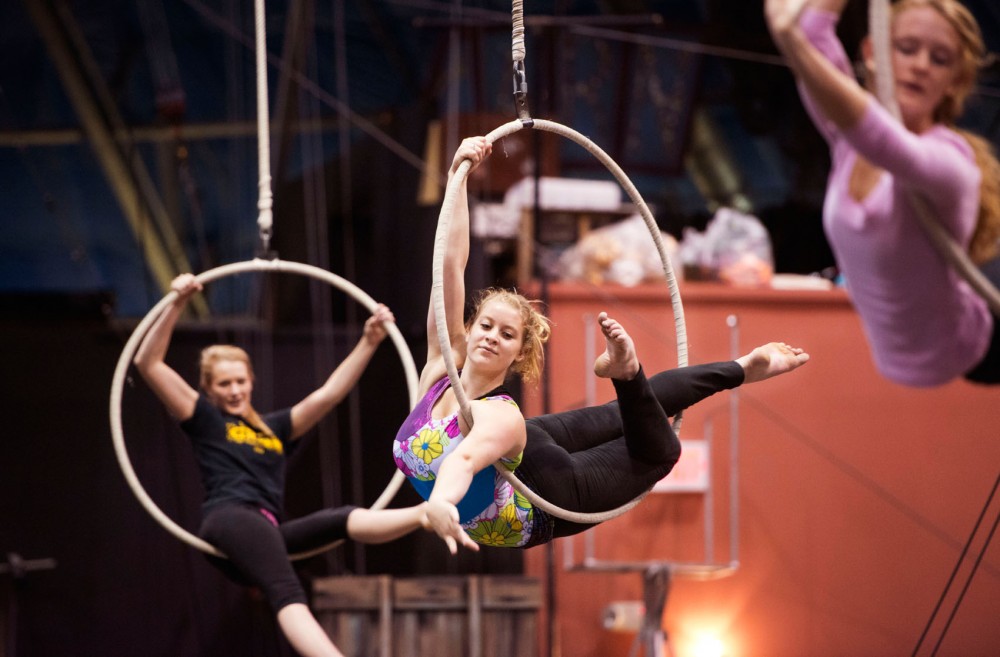Walking into the Circus Juventas big top is like entering the construction site of a world wonder. But it’s really the largest youth circus school in the country.
Budding acrobats tumble over stacked mats and clamber on equipment in the cavernous room, all under the watchful eye of a lattice work of exposed steel supports and girders.
“Once you have sawdust in the veins, it’s really hard to clear out,” co-founder of Circus Juventas Betty Butler said. “We were so nostalgic — we wanted to keep [circus] in our lives.”
Butler and her husband Dan established Circus Juventas 18 years ago.
The upcoming 2012 Gala will provide highlights of their Western themed summer production, “Showdown,” and a multi-course meal to raise funds for the 900-strong school.
Seven-year-old Olivia Abraham is one of the 900 enrolled in the entry-level circus experience class, which gives children a foundation in what the Butlers call the five genres of circus arts: acrobatics, juggling, theater, aerial and balance.
“We’ve done trampoline and something called web, and we also climbed the cloth and balanced on balls,” Olivia said.
There are multiple benefits for those participating in Circus Juventas.
“It does build their confidence,” Olivia’s father John Abraham said. “From the first class they were doing things that I was surprised at — it does give you a bit of a heart attack.”
During usual class hours, a red sash divides a section of seats from the main floor, allowing Abraham to have his heart attacks in the company of like-minded parents grappling with their children’s antics.
With so much going on, the activities of Circus Juventas encounter an almost semantic problem of classification.
“There’s really no good elevator speech for circus,” University of Minnesota freshman and Juventas performer Shena Tschofen said. “Most people think lions, tigers, bears and wire acts in tutus. What I do is a combination of theater and circus stunts — putting that together.”
The amount of stunts and skills that Circus Juventas represents is tremendous, including Russian barre, teeterboard, Cyr wheel, Spanish web, trapeze, wheel of steel, silks and Russian swing, to name a few. Think Cirque du Soleil — it’s the real deal.
On the teeterboard, a teeter totter-like apparatus, one person will jump on one side launching the other person into the air. The flyer will then land, hopefully, on the shoulders of a waiting student.
“Teeterboard is really intense,” 15-year-old Freddie McConnell said. “[When I started], I’d miss the catch and they’d land on my head — took me three months to start losing the habit.”
Overcoming latent fears and apprehension is one of the adjustments McConnell and other students need to make at Circus Juventas.
“Anybody who’s been through it knows that there’s a culture in itself,” Butler said. “In some ways, the average kid off the street would be uncomfortable.”
A newcomer would have to adjust to the vernacular and the bonds that a safety-first mentality brings. Individuals also find it difficult to describe their performances and experiences to others.
“You used to be able to just be an acrobat,” Tschofen said. “Now you have to more of what I call an actor-bat.”
Modern circus has evolved from its big-top beginnings to a performance art that incorporates a profusion of skills that individually would not seem out of place in things as diverse as breakdancing and rock-climbing.
“Theater is not necessarily traditional circus. Dancing is not necessarily traditional circus,” Tschofen said. “Is circus still circus if it’s not under a big top, or does it become something else?”




















